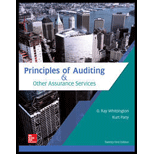
Principles Of Auditing & Other Assurance Services
21st Edition
ISBN: 9781259916984
Author: WHITTINGTON, Ray, Pany, Kurt
Publisher: Mcgraw-hill Education,
expand_more
expand_more
format_list_bulleted
Question
Chapter 9, Problem 43OQ
a.
To determine
Calculate the following items using the ratio method:
(1) Projected misstatement.
(2) Estimated total audited value.
b.
To determine
Calculate the following items using the difference estimation method:
(1) Projected misstatement.
(2) Estimated total audited value.
Expert Solution & Answer
Want to see the full answer?
Check out a sample textbook solution
Students have asked these similar questions
Explain why difference estimation is commonly used by auditors
In the blanks provided to the right below, select the letters of the underlying assumption, measurement method, qualitative criteria, or constraint most closely associated with the statements. Some letters may be used more than once and some may not be used at all.A. Separate-entity assumption G. MatchingB. Continuity assumption H. Historical costC. Relevance I. Unit-of-measure assumptionD. Time-period assumption J. Faithful representationE. Cost/benefit K. VerifiabilityF. Revenue recognition L. Full disclosure
1. Any accounting method is acceptable for small items that will not change users’ decisions. 2. Assumes that all financial statement elements can be meaningfully described in dollar terms. 3. Long-term assets that increase in value are not normally written up in the…
In testing for lower-of-cost-or-market, the auditor is gathering evidence to support which of the following assertions?
a. Accuracy.
b. Rights and obligations.
c. Valuation.
d. Pricing.
Chapter 9 Solutions
Principles Of Auditing & Other Assurance Services
Ch. 9 - Prob. 1RQCh. 9 - Prob. 2RQCh. 9 - Prob. 3RQCh. 9 - Prob. 4RQCh. 9 - Prob. 5RQCh. 9 - Prob. 6RQCh. 9 - Prob. 7RQCh. 9 - Prob. 8RQCh. 9 - Prob. 9RQCh. 9 - Prob. 10RQ
Ch. 9 - Prob. 11RQCh. 9 - Prob. 12RQCh. 9 - What is a dual-purpose test?Ch. 9 - Prob. 14RQCh. 9 - Prob. 15RQCh. 9 - Prob. 16RQCh. 9 - What would be the difference between an attributes...Ch. 9 - Prob. 18RQCh. 9 - Prob. 19RQCh. 9 - Prob. 20RQCh. 9 - Prob. 21RQCh. 9 - Prob. 22RQCh. 9 - Prob. 23RQCh. 9 - Prob. 24RQCh. 9 - Prob. 25RQCh. 9 - Prob. 26RQCh. 9 - Prob. 27RQCh. 9 - Prob. 28RQCh. 9 - Prob. 29QRACh. 9 - Prob. 30QRACh. 9 - Prob. 31QRACh. 9 - Prob. 32QRACh. 9 - Prob. 33QRACh. 9 - Prob. 34QRACh. 9 - Prob. 35QRACh. 9 - Prob. 36QRACh. 9 - Prob. 37AOQCh. 9 - Prob. 37BOQCh. 9 - Prob. 37COQCh. 9 - Prob. 37DOQCh. 9 - Prob. 37EOQCh. 9 - Prob. 37FOQCh. 9 - Prob. 37GOQCh. 9 - Prob. 37HOQCh. 9 - Prob. 37IOQCh. 9 - Prob. 37JOQCh. 9 - Prob. 37KOQCh. 9 - Prob. 37LOQCh. 9 - Prob. 38OQCh. 9 - Prob. 39OQCh. 9 - For each term in the first column below, identify...Ch. 9 - Prob. 41OQCh. 9 - Smith, Inc. Rachel Robertson wishes to use...Ch. 9 - Prob. 43OQCh. 9 - Prob. 44PCh. 9 - Prob. 45PCh. 9 - Prob. 46PCh. 9 - Prob. 47PCh. 9 - In the audit of Potomac Mills, the auditors wish...Ch. 9 - Prob. 49PCh. 9 - Prob. 50PCh. 9 - Prob. 51PCh. 9 - Prob. 52ITC
Knowledge Booster
Similar questions
- Activities carried out by the auditor using comparisons and relationships of accounts or data to assess whether the said accounts or data make sense (appear reasonable) are ...a. analytical proceduresb. comparing the accountsc. vertical analysisd. relationship modelarrow_forwardSelect and consider real-world assets and their correlation. Identify and discuss two assets or variables that exhibit a near - perfect positive correlation.. Identify and discuss two assets or variables that exhibit a near - perfect negative correlation. Discuss if the correlations are constant or dynamic. Explain the correlated relationship; also discuss validity of the data set and reading level.arrow_forward2.arrow_forward
- An essential step in difference estimation is the comparisonof each computed confidence limit with tolerable misstatement. Why is this step soimportant, and what should the auditor do if one of the confidence limits is larger thanthe tolerable misstatement?arrow_forwardTolerable error, is the maximum monetary error that the auditor is prepared to accept in the population and still conclude that audit objective has been achieved, is directly related to A.Sample size BAudit risk C.Materiality D.Expected errorarrow_forwardHow does it compare with the NPV based on the WACC method? (Select the best choice below.) A. The NPV computed using the FTE method cannot be compared to the NPV based on the WACC method. B. The NPV computed using the FTE method is always higher than the NPV based on the WACC method. C. The NPV computed using the FTE method is always lower than the NPV based on the WACC method. D. The NPV computed using the FTE method is the same as the NPV based on the WACC method.arrow_forward
- Ratio analysis provides sound conclusions. Select one: True Falsearrow_forwardIf the _______ is less than the _______, the audit team would conclude that the account balance is fairly stated.a. Projected misstatement; tolerable misstatement.b. Tolerable misstatement; projected misstatement.c. Upper limit on misstatements; tolerable misstatement.d. Tolerable misstatement; upper limit on misstatements.arrow_forwardFor each independent situation below, calculate the missing values.arrow_forward
- Which of the following is NOT a characteristic of effective information? a. relevance b. accuracy c. summarization d. precisionarrow_forwardExperimental outcomes that are based on measurement scales such as time, weight, and distance can be described by _____ random variables. a. uniform b. discrete c. continuous d. intermittentarrow_forwardExplain errors of principle and give two examples with measures to rectifythem.arrow_forward
arrow_back_ios
SEE MORE QUESTIONS
arrow_forward_ios
Recommended textbooks for you
 Auditing: A Risk Based-Approach (MindTap Course L...AccountingISBN:9781337619455Author:Karla M Johnstone, Audrey A. Gramling, Larry E. RittenbergPublisher:Cengage LearningPrinciples of Accounting Volume 1AccountingISBN:9781947172685Author:OpenStaxPublisher:OpenStax College
Auditing: A Risk Based-Approach (MindTap Course L...AccountingISBN:9781337619455Author:Karla M Johnstone, Audrey A. Gramling, Larry E. RittenbergPublisher:Cengage LearningPrinciples of Accounting Volume 1AccountingISBN:9781947172685Author:OpenStaxPublisher:OpenStax College

Auditing: A Risk Based-Approach (MindTap Course L...
Accounting
ISBN:9781337619455
Author:Karla M Johnstone, Audrey A. Gramling, Larry E. Rittenberg
Publisher:Cengage Learning


Principles of Accounting Volume 1
Accounting
ISBN:9781947172685
Author:OpenStax
Publisher:OpenStax College